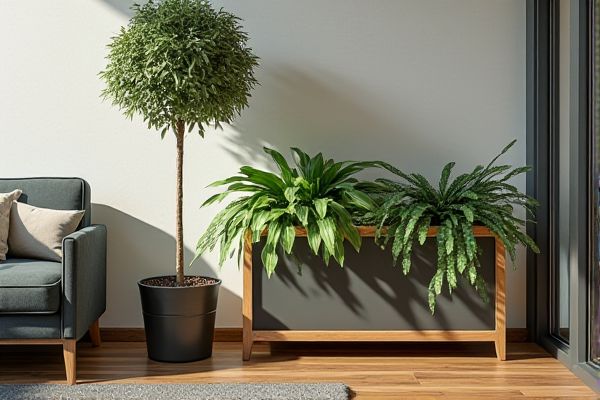
Rail planters maximize your outdoor space by attaching securely to balcony or deck railings, offering elevated greenery without occupying floor area. Floor planters provide versatility and stability for larger plants but require ample ground space, making it essential to choose the option that best fits your environment; explore the rest of the article to determine which planter suits your needs.
Table of Comparison
| Feature | Rail Planter | Floor Planter |
|---|---|---|
| Placement | Mounted on balcony or deck rails | Placed directly on the ground or floor |
| Space Saving | Optimizes vertical space, ideal for small areas | Requires floor space, suitable for larger areas |
| Installation | Securely clamps or hooks to railings | No installation needed, portable |
| Plant Size | Best for small to medium plants | Supports larger plants and trees |
| Material | Often made from lightweight metal or plastic | Varies: ceramic, plastic, wood, or metal |
| Drainage | Requires drainage holes to prevent water buildup | Usually built-in drainage or requires manual drainage |
| Mobility | Fixed in place | Can be moved easily |
Introduction to Rail Planters and Floor Planters
Rail planters are designed to securely attach to balcony or deck railings, maximizing space by elevating plants and enhancing outdoor aesthetics without occupying floor area. Floor planters, in contrast, provide versatility in placement and size options, supporting larger plants and offering stability on any flat surface. Choosing between rail and floor planters depends on your available space and the type of gardening setup you prefer.
Key Differences Between Rail Planters and Floor Planters
Rail planters are designed to attach securely to balcony or deck railings, optimizing vertical space and enhancing outdoor areas without occupying floor space. Floor planters are freestanding containers placed directly on the ground or flooring, offering more stability and capacity for larger plants. Rail planters typically feature brackets or hooks for mounting, while floor planters come in various sizes and shapes to support diverse gardening needs and styles.
Advantages of Using Rail Planters
Rail planters offer space-saving benefits by attaching to railings, maximizing garden area without occupying floor space. They provide improved drainage and air circulation compared to floor planters, promoting healthier plant growth. Elevated positioning in rail planters also protects plants from pests and allows easier maintenance and watering.
Benefits of Floor Planters for Indoor and Outdoor Spaces
Floor planters enhance indoor and outdoor spaces by providing versatile uses such as housing large plants that improve air quality and aesthetic appeal. Their sturdy construction ensures durability against weather conditions outdoors while seamlessly fitting into interior design themes. Unlike rail planters, floor planters offer greater stability, larger capacity for soil and root growth, and easier access for maintenance.
Rail Planters: Best Applications and Placement Ideas
Rail planters excel in maximizing limited balcony or deck space by securely attaching to railings, making them ideal for urban apartments and small outdoor areas. These planters support climbing plants, herbs, and flowers, enhancing vertical greenery while saving floor space. Placement along balcony edges or stair rails provides both aesthetic appeal and safety without cluttering walkways or seating areas.
Floor Planters: Versatility and Design Choices
Floor planters offer unmatched versatility with a wide array of materials, shapes, and sizes suitable for both indoor and outdoor environments, enhancing any space's aesthetic appeal. Their design options range from modern minimalist to traditional ornate styles, allowing seamless integration into diverse decor themes. Unlike rail planters, floor planters can accommodate larger plants, facilitating rich greenery displays and improving indoor air quality.
Space-Saving Solutions: Rail Planters vs Floor Planters
Rail planters offer superior space-saving solutions by attaching directly to balcony or deck railings, freeing up valuable floor space for other uses. Floor planters, while versatile in placement, occupy significant ground area which can limit movement or reduce usable outdoor space. For small balconies or compact patios, rail planters maximize planting capacity without compromising valuable walking or seating areas.
Maintenance and Durability Comparison
Rail planters typically require less maintenance due to their elevated design, which reduces soil erosion and water drainage issues common in floor planters. Floor planters, exposed to direct ground contact, are more susceptible to wear from moisture, pests, and shifting soil, potentially decreasing their durability over time. Your choice should consider these factors to ensure long-lasting performance and ease of upkeep.
Choosing the Right Planter for Your Needs
Rail planters are ideal for balconies and small outdoor spaces where maximizing vertical space is essential, offering sturdy attachment to railings while enhancing aesthetics. Floor planters provide versatile placement options, support larger plants or arrangements, and are suitable for patios, entryways, or indoor settings where mobility and size are priorities. Selecting between rail and floor planters depends on space constraints, desired plant size, and location flexibility for optimal growth and design.
Conclusion: Which Is Better – Rail Planter or Floor Planter?
Rail planters maximize space by attaching securely to balcony or deck railings, offering elevated planting opportunities ideal for small outdoor areas. Floor planters provide greater versatility in size and design, accommodating larger plants and easier mobility, making them suitable for expansive patios or indoor use. Choosing between rail and floor planters depends on available space, desired plant types, and aesthetic preferences, with rail planters favored for compact areas and floor planters preferred for more substantial planting needs.
 homyna.com
homyna.com